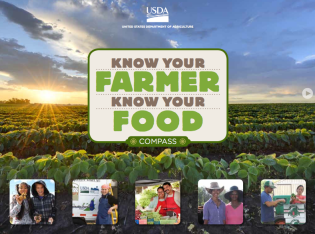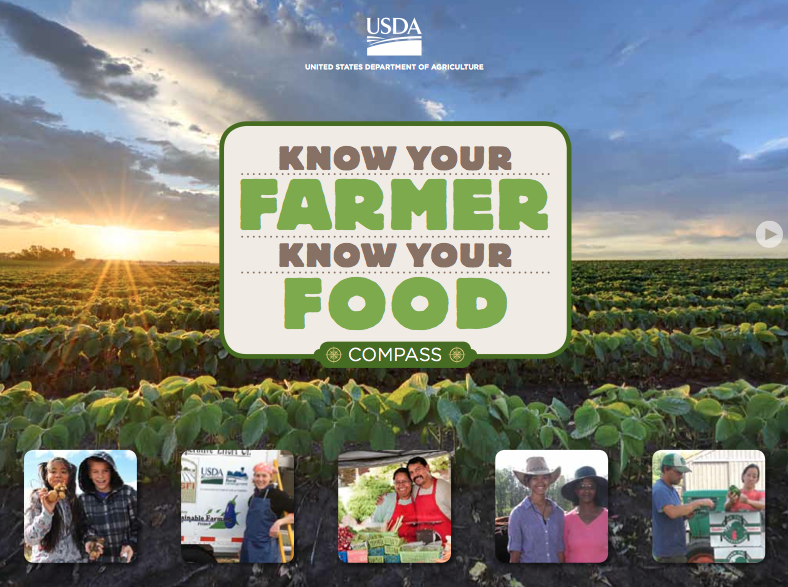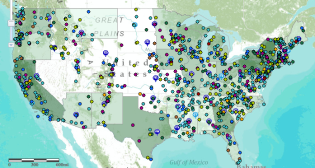 Today, most of us see “local” as shorthand for fresh, delicious food that comes with a story attached — and that serves an alternative to consolidated, anonymous, commodity-based farming. But that hasn’t always been how the United States Department of Agriculture (USDA) sees it.
Today, most of us see “local” as shorthand for fresh, delicious food that comes with a story attached — and that serves an alternative to consolidated, anonymous, commodity-based farming. But that hasn’t always been how the United States Department of Agriculture (USDA) sees it.
USDA is known for creating, subsidizing, and promoting industrial agriculture. So the agency’s effort to dip its toes into the local food movement in 2009 with its Know Your Farmer, Know Your Food program (KYF2) raised eyebrows and questions. Could USDA really help create a thriving bottom-up food system? Or would it spread the term local, and the ethos behind it, so thin as to make it meaningless?
Know Your Farmer, Know Your Food essentially re-packaged and highlighted government programs that support and promote the development of local farmers and ranchers. The funds it made available are a drop in the bucket (at a few hundred million dollars, spread across 27 programs run by nine different agencies that support local food efforts in some way) when compared to the tens of billions the USDA puts toward the “Big Five” commodity crops — corn, soy, wheat, cotton, and rice.
But that didn’t make it insignificant. In fact, as KYF2 appeared in 2009, former Grist food editor Tom Philpott admitted to feeling cautiously optimistic about the effort. He wrote:
… it’s remarkable and to my knowledge unprecedented that the USDA is making a major effort to publicize these programs and ensure that at least some federal money flows into emerging alternative food systems.
This month, the USDA is making a very public effort to report its progress with the KYF2 program after two-and-a-half years. The agency has held several press events, including a live-streaming conversation from the USDA headquarters last week, another from the White House on Monday (that included the first family’s head chef/resident looker, Sam Kass), and an ongoing attempt at a conversation via a hashtag on Twitter.
The agency has released what it calls the Compass, a series of documents, case studies, tools, and an interactive map (above) designed to be a living representation of the KYF2 effort and its resources. The Compass includes anecdotes about scrappy, likable farmers, ranchers, and other business owners who’ve used USDA dollars for things like food co-ops, small meat processors, hoop houses, and artisan cheese operations. And most who take the time to dig in to the somewhat dry materials will likely be convinced that real work and concrete change is taking place — even if they’re ultimately dwarfed by the USDA’s agribusiness efforts.
But the USDA’s media blitz also raises a disturbing question, if we look closely: Does the agency see local food as any sort of alternative to industrial-scale (or “production”) agriculture? Or is it more of a garnish — say, a sprig of parsley — meant to make our nation’s heaping plate of corn and soy more appetizing?
This scene from last week’s live stream might shed some light on the answer.
Agriculture Secretary Tom Vilsack and Deputy Secretary Kathleen Merrigan are sitting together talking to an online audience flanked by the USDA seal and the American flag. Off to the side is a screen, where every few minutes a question that’s been asked by an audience member via Twitter or email will pop up for the secretary and deputy to read out loud and answer.
After a promotional slideshow and several fairly benign questions about the KYF2 effort, an anonymous question appears on the screen (it’s at 17:55, for those of you following along at home). “How can local foods complement production agriculture?,” it reads.
Here’s what they have to say:
Vilsack: “This is a really important question. Because when KYF2 got launched, there was this belief that somehow it was separate from production agriculture.
We have always thought that it complements production agriculture. That it actually … increases the connection between consumers and people that are distant from the farm. The reality is that so many people who live in America today are generations removed from family members who farmed. So they may not have an appreciation for the challenges of farming … ” [See the video for his complete statement.]
Merrigan: “One person quoted in the Compass said …’ Those of us doing the local/regional food work are ambassadors for American agriculture.’ … That resonated with me because they’re putting that face on farming that I think is so important for all our constituents at USDA.” [Emphasis mine.]
In other words, small producers working their behinds off on a local scale — who may get small loans but generally receive no subsidies, little to no crop insurance, and no lobbying power from organizations in Washington like the Farm Bureau — are valuable to the USDA because they make all farmers look much better by proxy.
Now, irony aside, why would USDA feel the need to dedicate so much time to making the point that stronger local economies should be in no way threatening to Big Ag interests?
Well, some large producers have shown themselves to feel threatened by local food. Take this 2010 example, described by Don Carr of the Environmental Working Group, wherein an Iowa corn and soybean grower who is chair of the Iowa Corn Promotion Board spoke up to criticize Merrigan’s early KYF2 efforts as “not the USDA that people in the Midwest are familiar with.”
There’s also the fact that a number of the services and funds KYF2 is highlighting were products of the 2008 Farm Bill. Since the Senate Agriculture committee is in the midst of holding hearings about the 2012 Farm Bill, Merrigan and others behind Know Your Farmer probably feel they have a case to make.
The day after the Compass was announced, Republican Sen. Pat Roberts (Kan.) publicly criticized the KYF2 effort: It’s not “steeped in reality,” he said, since most food Americans consume isn’t grown locally. In a story that ran on the industry site Agri-pulse, he was quoted saying that the initiative would be the subject of discussion at the Senate Ag Committee hearing. He continued:
Would taxpayer dollars be better invested elsewhere, like research, pest and disease management that help the entire industry, rather than one particular farmers’ market.
I’m guessing Merrigan and her staff understand the benefit of playing up local food’s “complementary” qualities in public, while doing work behind the scenes that could — even in small ways — begin shifting the power in American farming back towards small-scale producers and local infrastructure.
In fact, depending on how the 2012 Farm Bill shakes out, I have a hunch that the KYF2 effort will either be seen as a foundation on which the next several decades of system-changing local food work are built and strengthened, or a brief moment of possibility that very few of us truly understood while it lasted.





